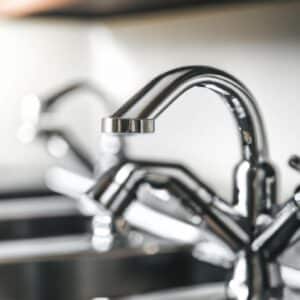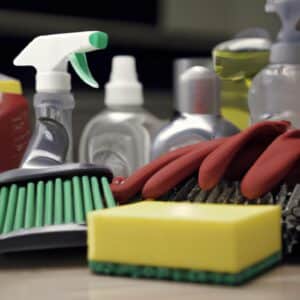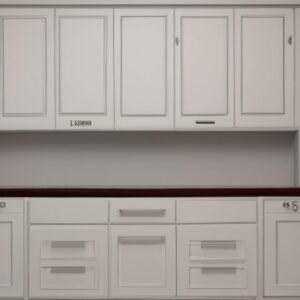It’s no secret that a clean kitchen is the key to a healthy home. From protecting your family from food-borne illness to keeping pests away, the importance of keeping your kitchen clean cannot be overstated. But with so many items to clean and so many potential hazards, how do you make sure that your kitchen is squeaky clean? That’s why we’ve put together this guide to help you get the ultimate kitchen cleaning routine. From the best cleaning tips and tricks for paper towels, hot water, soapy water, warm water, cutting boards, tea towels, coffee makers, dish soap, clean cloths, white vinegar, and spray bottles, we’ve covered all the bases. So, let’s get started on the path to kitchen cleaning perfection!
Paper Towels
Keeping your kitchen clean is essential when it comes to preventing food-borne illness, and one of the simplest and most effective ways to do this is through the use of paper towels. Not only are paper towels incredibly versatile, but they are also very easy to use. When it comes to cleaning kitchen surfaces, paper towels are an ideal solution. They can be used dampened with warm water and dish soap for general cleaning, or they can be used with a household cleaner for more intense jobs. Paper towels can also be used to quickly dry off surfaces and items, helping to reduce the amount of bacteria present. When it comes to cleaning up kitchen messes, paper towels are a must-have. They can be used to soak up spills, dab away water and grime, and even pick up tiny pieces of food from the counter or floor. For the ultimate clean, make sure to keep a stock of paper towels on hand at all times.
Hot Water
Hot water is a powerful cleaning tool. It is effective at removing dirt and grease, and it’s especially good for removing bacteria that can lead to food-borne illnesses. Hot water can be used to sterilize dishes, cutting boards, countertops, and other kitchen surfaces. It is also helpful for cleaning pots and pans that have been exposed to high heat.
Using hot water for cleaning has many benefits. Hot water is an effective way to sanitize kitchen surfaces, which helps to reduce the risk of foodborne illnesses. Hot water is also effective at breaking up dirt and grease, and it can help to dissolve stuck-on food particles. Additionally, hot water can be used to remove oil and grease from kitchen appliances like ovens, stoves, and microwaves.
When using hot water to clean, it is important to use caution. Hot water can burn skin, and it can cause some surfaces to warp or discolor if they are not heat-resistant. It’s also important to use a clean cloth or sponge when cleaning with hot water. This will help to prevent the spread of bacteria and other germs. Finally, it’s important to be sure that all surfaces are thoroughly rinsed with cold or lukewarm water before they are dried.
Soapy Water
Using soapy water to keep your kitchen clean is one of the most important steps to preventing food-borne illness. The combination of soap and water creates a powerful cleaning agent that can break down grease, fat, and bacteria on kitchen surfaces. Plus, the addition of soap helps to reduce the spread of bacteria and germs from one surface to another.
When using soapy water to clean kitchen surfaces, it’s important to use warm water so that the soap will dissolve properly. Start by filling your sink with warm water and a generous squirt of dish soap. Use a clean dishcloth or sponge to work the soap into the water to create suds. Then, dip the cloth or sponge into the soapy water and use it to scrub down hard surfaces like countertops, tables, and cutting boards. Make sure to rinse the cloth or sponge out in between each scrub to keep the soap from getting too concentrated. Once you’re done, rinse the surfaces with clean water and dry them with a paper towel.
For smaller kitchen appliances, a soapy water mixture can be used to give them a good scrub down. Mix a few drops of dish soap into a spray bottle filled with warm water and spray it on the surface. Rub with a clean cloth or sponge, then wipe away with a damp cloth and dry with a paper towel. With these simple steps, your kitchen will be squeaky clean and free from food-borne illness.
Warm Water
Warm water is an essential part of your kitchen cleaning routine. Not only can it be used to clean dishes, utensils, and surfaces, but it can also be used to clean the surfaces of your kitchen sink. When cleaning with warm water, it is important to remember to use hot enough water to kill germs and bacteria, but not hot enough to cause burns. The temperature should be warm but not scalding. Warm water is also great for deep cleaning, as it can help loosen and remove stuck-on food and grease. Additionally, warm water can make it easier to effectively disinfect surfaces and protect against food-borne illnesses.
When cleaning with warm water, it is important to use a mild dish soap to help break down grease, dirt, and grime. Be sure to use a clean sponge or cloth to wipe surfaces down, and use a clean cloth to dry surfaces after washing. Additionally, if you are using a spray bottle, make sure to rinse the spray bottle with warm water after each use to ensure it is clean and free of bacteria. Finally, be sure to dispose of any cleaning solutions that you have used to avoid cross-contamination.
Cutting Boards
Cutting boards are an essential tool for any kitchen. They provide a clean, safe surface for preparing food, and can also help keep your counters and knives clean and free of foodborne illness. However, cutting boards need to be cleaned regularly to keep them in top shape. Here are some tips and tricks for cleaning your cutting boards:
- Use hot, soapy water to clean your cutting boards. It is best to use a dish rag and scrub the board with a dish soap. Be sure to rinse the board well and dry it thoroughly with a clean towel.
- Use a white vinegar and water solution to disinfect your cutting board. Fill a spray bottle with equal parts white vinegar and water and spray the board with the solution. Let the board sit for two minutes before rinsing off with hot water.
- Use a cutting board specific cleaning product to sanitize your board. These products contain natural ingredients that help break down food particles and neutralize bacteria.
- Place cutting boards in the dishwasher after they have been cleaned with hot, soapy water. This will help sanitize the board and ensure that it is completely clean.
- After using a cutting board, place it upside down on a dry surface to allow air to circulate. This will help keep the board dry and prevent bacteria from growing.
By following these tips and tricks, you can keep your cutting boards clean and free of foodborne illness. Cleaning your cutting boards regularly is an important part of maintaining a safe and healthy kitchen.
Tea Towel
A tea towel is a great tool for keeping your kitchen clean and preventing food-borne illness. It’s absorbent, making it perfect for wiping down surfaces and soaking up spills. Plus, it’s reusable so you can use it again and again. The benefits of a tea towel are plentiful: it’s machine-washable, lightweight, and dries quickly. Plus, it generally doesn’t require too much effort to keep clean, as it’s usually made from a material that’s easy to launder.
Here are some tips and tricks for using a tea towel for cleaning:
- Make sure to keep your tea towel clean and fresh by washing it often.
- Use it to dry dishes – it’s great for wiping down plates, bowls, cups, and other items.
- Use it to wipe down countertops and other surfaces – a tea towel is great for absorbing spills and wiping down surfaces.
- Use it to wipe down the outside of the refrigerator – a damp tea towel is perfect for wiping away dust and dirt from the outside of the fridge.
- Use it to clean windows and mirrors – a tea towel is great for wiping away streaks and smudges.
- Use it to wipe down the stovetops – wiping down the stovetops with a damp tea towel is a great way to keep them clean and shine.
- Use it to mop up spills – it’s perfect for absorbing liquid messes.
- Use it to line the counter when chopping vegetables – a tea towel is great for catching scraps and keeping the counter clean.
Coffee Maker
Having a coffee maker in the kitchen can be a great convenience, but it’s also important to make sure it’s properly cleaned and maintained. Hot water and dish soap are great ingredients for a clean coffee maker. Before using hot water, it’s important to make sure the machine is completely off and unplugged. When it comes to using dish soap, use only a few drops and make sure it is diluted with warm water. The combination of hot water and dish soap will help to break down any grease or residue. After soaking for a few minutes, use a clean cloth to wipe down the inside and outside of the coffee maker. To give it an even deeper clean, try using a mixture of white vinegar and warm water. The vinegar will help to get rid of any lingering bacteria or odors. Use a spray bottle to spray the vinegar mixture onto the interior of the coffee maker. Allow it to sit for a few minutes, then use a damp cloth to wipe down the machine before rinsing with warm water. For an even deeper clean, let the coffee maker soak in the vinegar mixture for a few hours. With these tips and tricks, you can keep your coffee maker clean and running smoothly.
Dish Soap
Using dish soap properly is essential to keeping your kitchen clean. Dish soap is a great tool for cleaning dishes, pots, and pans. It can also be used to clean countertops, floors, and other surfaces. Dish soap is mild and gentle, yet powerful enough to remove grease, grime, and bacteria.
When using dish soap, always use hot water. Hot water will help to dissolve the soap, making it more effective. Add a few drops of dish soap to the water and mix it until the soap is fully dissolved. Use this solution to scrub dishes, pots, and pans. Use a clean cloth or sponge for best results. To clean countertops, floors, and other surfaces, use a spray bottle filled with the dish soap and water solution. Spray the solution onto the surface and wipe it down with a clean cloth.
For tougher stains and stuck-on food, make a paste of dish soap and baking soda. Spread the paste onto the stain and let it sit for a few minutes before scrubbing. Once the stain is gone, rinse the area with hot water.
When you’re done cleaning with dish soap, make sure to empty the sink and rinse it thoroughly. Dish soap can leave an unpleasant residue if not removed properly. You can also use white vinegar and water to help remove any leftover soap residue.
Clean Cloths
Using a clean cloth is one of the best ways to keep your kitchen clean. It is an easy and affordable way to ensure that germs and bacteria do not spread, and to make sure that your kitchen is spotless. Clean cloths can be used to wipe down counters, clean dishes, clean up spills, and mop up messes.
When using clean cloths, it is important to make sure that you are using clean cloths each time. You don’t want to spread bacteria among different surfaces, so be sure to use a fresh cloth for each task. To ensure the cloths are always clean, it is best to wash them in hot, soapy water after each use. You can also add a bit of white vinegar to the water to disinfect and help with stain removal. For added convenience, you can keep a small spray bottle filled with a solution of water and vinegar to use when wiping down counters and surfaces.
Using clean cloths is an essential part of any kitchen cleaning routine. It is a great way to keep your kitchen clean and germ-free. With the right supplies and a bit of time, your kitchen can be spotless and ready for your next meal.





